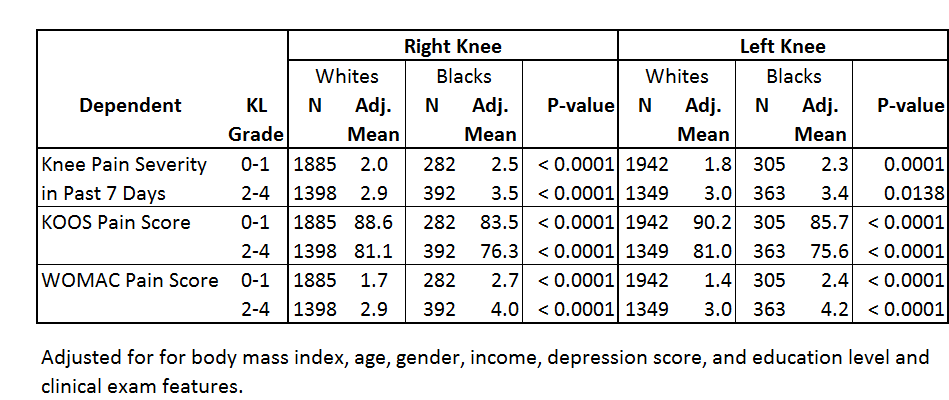Session Information
Session Type: Abstract Submissions (ACR)
Background/Purpose:
African Americans have a higher prevalence of both radiographic and symptomatic radiographic knee osteoarthritis (OA) than Caucasians. In addition, African Americans with knee OA report more pain than Caucasians. While the reasons for these disparities are poorly understood, differences in risk factor patterns and/or pathoanatomic characteristics have been suggested. We hypothesized that these racial differences might be explained by differences in findings found upon physical examinations, even while stratifying by radiographic severity.
Methods:
Racial differences in pain reporting and severity as well as radiographic and physical examination findings of the knees were assessed using baseline data from subjects enrolled in the Osteoarthritis Initiative (OAI), a multicenter, longitudinal observational study initiated in 2004 to examine biomarkers and risk factors for clinically significant knee OA. This analysis was limited to 690 African Americans and 3,337 Caucasians with complete data from the baseline visit for knee pain, clinical knee exam features, covariates of interest and bilateral fixed-flexion knee radiographs that had been centrally read for OA using the Kellgren-Lawrence (KL) scale. Three measures of pain severity (KOOS, WOMAC and NRS) were analyzed for each knee. We first evaluated racial differences in clinical exam findings using logistic regression models. We next used ANCOVA to determine if race was associated with pain severity while adjusting for anthropometric and demographic variables (body mass index, age, gender, income, depression score, and education level). Analyses were stratified into two groups by radiographic severity (KL=0 or 1 and KL ≥ 2). Finally, we additionally adjusted for clinical exam features that were significantly different between the racial groups.
Results:
Patellar quadriceps tendinitis, lateral and medial tibiofemoral joint line tenderness, patellofemoral crepitus and grind, and pain on knee flexion were more common in blacks than whites (p<0.008 for all). No significant differences between racial groups were observed for static alignment, anserine bursa pain or presence of effusion. Blacks reported more knee pain for all three measures of pain severity (p<0.0001) regardless of radiographic severity. After adjusting for differences in knee examination, blacks still reported more knee pain for all three measures of pain severity: adjusted means and P-values are reported in Table 1.
Conclusion:
These results demonstrate that African Americans report more knee pain than Caucasians and that this finding cannot be explained by features found upon knee examination or differences in radiographic severity. Further analyses will examine the potential role of coping mechanisms, psychosocial health and findings on magnetic resonance imaging of the knees.
Disclosure:
P. Luneburg,
None;
L. Yerges-Armstrong,
None;
B. D. Mitchell,
None;
M. C. Hochberg,
Abbott Laboratories, Astra-Zeneca, Bioiberica S.A., Eli Lilly Inc., Genentech/Roche, Merck Inc., Novartis Pharma A.G., Pfizer Inc., Stryker LLC, Xoma.,
5.
« Back to 2012 ACR/ARHP Annual Meeting
ACR Meeting Abstracts - https://acrabstracts.org/abstract/racial-differences-in-reported-knee-pain-severity-persist-even-after-adjustment-for-knee-examination-and-radiographic-findings-data-from-the-osteoarthritis-initiative/

